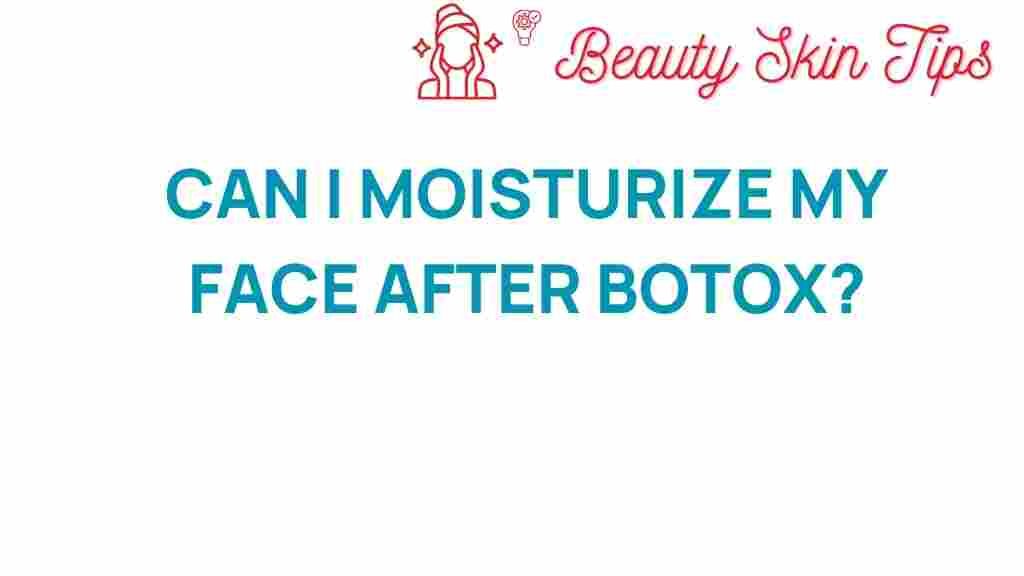Can Moisturizing Your Face After Botox Boost Results?
Botox has become a popular cosmetic treatment for reducing wrinkles and fine lines, giving many individuals a more youthful appearance. While many focus on the injection process itself, the aftercare that follows is just as crucial. One common question among Botox patients is whether moisturizing their face after the treatment can enhance the results. In this article, we will explore how moisturizing can impact your Botox experience, the best practices for post-Botox skincare, and whether there are any precautions you should consider.
Understanding Botox
Before diving into the relationship between moisturizing and Botox, it’s essential to understand what Botox is. Botox, or Botulinum toxin, is a neurotoxic protein used to temporarily paralyze muscles, which helps to smooth out wrinkles. It is primarily used on the forehead, around the eyes, and other areas of the face where dynamic wrinkles occur.
After Botox treatment, the skin may feel slightly different, and proper aftercare can play a significant role in optimizing the results. One of the most common aftercare tips is to keep the skin hydrated. But how exactly does this affect your Botox results?
Benefits of Moisturizing After Botox
Moisturizing your face after receiving Botox can provide several benefits:
- Hydration: Keeping the skin hydrated can promote healing and maintain skin elasticity, which is crucial after any cosmetic procedure.
- Comfort: Some individuals may experience dryness or tightness in the treated areas. A good moisturizer can alleviate these sensations.
- Enhanced absorption: Moisturizers can help the skin absorb other beneficial ingredients, such as serums or treatments, more effectively.
- Protection: A quality moisturizer can create a barrier that protects the skin from environmental stressors.
The Step-by-Step Process of Caring for Your Skin After Botox
To ensure you get the best results from your Botox treatment, follow these steps for post-care:
1. Wait Before Moisturizing
Immediately after your Botox treatment, it is advised to avoid touching your face or applying any products for at least four hours. This waiting period allows the Botox to settle in the targeted muscles without interference.
2. Choose the Right Moisturizer
Not all moisturizers are created equal. After Botox, opt for a gentle, fragrance-free moisturizer. Look for ingredients that are hydrating and soothing, such as:
- Hyaluronic acid
- Glycerin
- Aloe vera
- Ceramides
These ingredients help maintain hydration and support the skin barrier, which is essential after any cosmetic treatment.
3. Apply Moisturizer Gently
When you start moisturizing, be gentle. Use your fingertips to apply the product in a soft, upward motion. Avoid rubbing or applying too much pressure on the treated areas, as this can disrupt the Botox.
4. Follow a Consistent Routine
Consistency is key when it comes to skincare. Make moisturizing a part of your daily routine to help keep your skin hydrated and support the longevity of your Botox results. Apply moisturizer twice daily, in the morning and evening, for best results.
5. Stay Hydrated
In addition to topical moisturizing, ensure you are drinking plenty of water. Hydration from the inside helps keep your skin looking plump and youthful, complementing the effects of Botox.
6. Avoid Certain Ingredients
While moisturizing is beneficial, be cautious about certain products. Avoid any products containing:
- Retinoids
- Exfoliating acids (AHAs or BHAs)
- Alcohol-based toners
These ingredients can irritate the skin, which may compromise your Botox results or prolong the healing process.
Troubleshooting Tips for Post-Botox Moisturizing
Even with the best intentions, you may encounter some issues after your Botox treatment. Here are some troubleshooting tips:
1. If You Experience Redness or Swelling
Redness and swelling are common side effects after Botox. If you notice these symptoms:
- Apply a cold compress to the affected area.
- Continue to moisturize gently, avoiding any products that might irritate the skin.
- Consult your healthcare provider if the symptoms persist.
2. If Your Skin Feels Tight or Dry
If your skin feels tight or dry after Botox, ensure you are using a rich moisturizer and consider adding a hydrating serum that contains hyaluronic acid. This combination can significantly improve your skin’s hydration levels.
3. If You Have Allergic Reactions
In rare cases, individuals may have an allergic reaction to a moisturizer. Signs of an allergic reaction include:
- Itching
- Rash
- Hives
If you experience any of these symptoms, discontinue use immediately and contact your healthcare provider.
4. When to Seek Professional Help
If you have any concerns about your Botox results or the condition of your skin post-treatment, do not hesitate to reach out to your injector or dermatologist. They can provide personalized advice and solutions tailored to your skin type and treatment.
Conclusion: Enhance Your Botox Results with Proper Skincare
In conclusion, moisturizing your face after Botox can significantly enhance your results by promoting hydration, comfort, and skin health. By following a proper skincare routine that includes gentle moisturizing, you can maximize the benefits of your Botox treatment. Remember to choose the right products, be consistent, and listen to your skin’s needs. If you’re looking for more tips on skincare after Botox, feel free to check out our other articles on skincare here.
With the right care, your skin can continue to look fresh and youthful long after your Botox treatment. Always consult with your doctor or skincare professional for tailored advice based on your unique skin type and treatment plan. For more information about Botox and its effects, visit the American Society of Plastic Surgeons.
This article is in the category Treatments and created by BeautySkinTips Team
